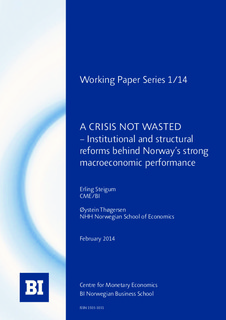| dc.contributor.author | Steigum, Erling | |
| dc.contributor.author | Thøgersen, Øystein | |
| dc.date.accessioned | 2015-12-07T12:52:42Z | |
| dc.date.available | 2015-12-07T12:52:42Z | |
| dc.date.issued | 2014 | |
| dc.identifier.issn | 1503-3031 | |
| dc.identifier.uri | http://hdl.handle.net/11250/2367193 | |
| dc.description.abstract | The systemic banking crisis and speculative attacks on the Norwegian krone in the early 1990s were the last in a series of blows to Norway’s macroeconomic policy regime. In addition to the recession after 1988, the underlying growth potential of the Mainland economy was also weak, despite financial deregulation and improved competitiveness. The large decline in the price of oil in the mid-1980s had demonstrated the risk of uncertain oil revenues as an important source of income to the government. The political awareness of an economic crisis paved the way for a series of structural reforms and changes in the macroeconomic policy regime.
This paper draws the line between the Norwegian boom-bust cycle and crises in the late 1980s and early 1990s, the succeeding institutional and structural reforms, and the strong macroeconomic performance and stability of the last two decades. | nb_NO |
| dc.language.iso | eng | nb_NO |
| dc.publisher | BI Norwegian Business School, Centre for Monetary Economics | nb_NO |
| dc.relation.ispartofseries | CME Working Papers;1/2014 | |
| dc.title | A crisis not wasted: Institutional and structural reforms behind Norway’s strong macroeconomic performance | nb_NO |
| dc.type | Working paper | nb_NO |
| dc.source.pagenumber | 43 | nb_NO |
| dc.source.issue | 1 | nb_NO |
